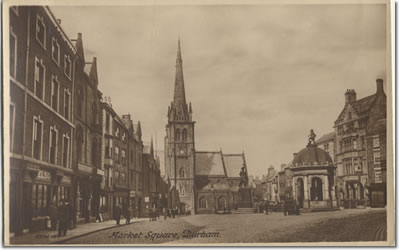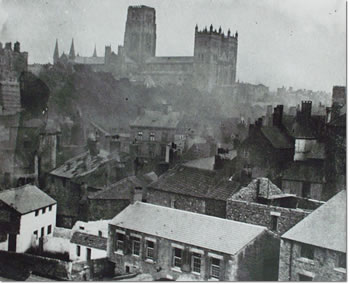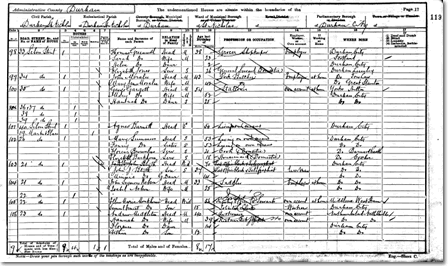
Who lived there?

Photograph showing Durham Market Place, c1910. (DUL Ref: Gibby City/A/99).

Photograph of late 19th or early 20th century housing in Durham city centre. (DUL ref Gibby A/CITY/92)
There were always more than just shops in the Market Place. For some people, the Market Place was also their home. There were shopkeepers of course, who lived above the shops with their families. Some of the rooms above the shops might also be rented by other people. If you look at the top photograph of the Market Place, you can see some of the flats above the shops.
Now have a look at the second photograph. This is a view of houses near the Market Place. People were living here as well. In our investigation we’ll see what sort of people lived in each of these places.
So… we know from these photographs that there were houses and flats in and near the Market Place were people could live but how can we find out more about the people who did live there? One of the best sources to use is the Census.
You can find out more about the Census or move straight on to finding out about a family who lived there in 1901.

Census entry for 20 Market Place. (Image courtesy of The National Archives and DCRO. Ref: RG 13/4682/119/17). Click on image to enlarge.
This source is the entry for 20 Market Place from the Census of 1901. Read it carefully and then answer the questions below. Reading the handwriting from the 19th and early 20th centuries can be quite tricky. If you get stuck look at the enlarged version of the image or use the transcript.
1. Who is listed as the head of the household?
2. Look at the next name on the list. Who is it? What is their relationship to the head of the household? What does this tell you about the people who lived there?
3. Who else lives there? Are they all related? (Clue – look at the occupations of the last two people listed, Florence and Elizabeth.)
4. What do you think is meant by ‘living on their own means’? Do you think this means Mary Summers was rich or poor?
5. What else can this census entry tell us about what the Market Place was like in the past?
You won’t find him on this census entry, but we know from the 1891 Census that Mary and Fanny’s father was Thomas Summers. Thomas Summers lived his whole life at 20 Market Place. He died in 1898 and was buried at St Nicholas’. You can find out more about that Church or look at another house on the Census.

Census entry for a yard near Silver Street. (Image courtesy of The National Archives and DCRO. Ref: RG 13/4682/116/12). Click on image to enlarge.
This source is the entry for a house in a yard near Silver Street. A yard was a group of houses built around a small space. These were smaller houses or flats that were cheaper to live in. Read it carefully before answering the questions. Remember that there is an enlarged version and a transcript to help you in this task.
1. Who is listed as ‘head of the household’? What is his occupation?
2. Do you think that this means he was rich or poor?
3. Who is listed next and what is their relationship to the head of the household?
4. Look at the names and ages of the rest of the people in the house. What does this tell you about the people who lived there? (Clue – look at their ages and relationship to the head of the household.)
So now we know a little bit about two families who were living in the Market Place in 1901. Let’s find out more by looking at where in the Market Place these families were living.

Map of the Market Place. (DCRO ref: DP 27/01/13A). Click on image to enlarge.
Look at this map of Durham City centre. Can you see the Market Place? Now look for Silver Street. If you look at the buildings there, you will see that there appears to be spaces behind. These are the courtyards like the one that the Hamiltons lived in.
1. Do any of these yards have names? What does this tell you about them?
Look how close the yards are to the Market Place where Mary Summers and her sister were living with their servants.
2. What does this tell you about what the Market Place was like in 1901?
So what do we know about the Market Place in 1901? We know that all sorts of people, rich and poor, lived there. We also know that sometimes the poor people were living quite close to their rich neighbours but their lives would have been very different!
Now why not try to find out what people could buy from the Market Place?
